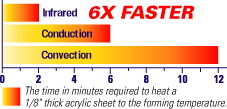Infrared heaters achieve a high heating efficiency as a result of the correlation between the output wavelength of the infrared heater and the absorption wavelength of many materials. The peak absorption of water is found at 3.0 microns, which falls right in the center of the medium wavelengths. Drying applications require the removal of water. Therefore, it is desirable to correlate the heater output and absorption of water. The peak absorption of most plastics and powder coatings is from 3.5 - 4 microns. The absorption of many materials mirrors the output of infrared heaters. Generating infrared heater energy at the same wavelength as the absorption wavelength of the material maximizes the heat transfer and the process speed. Additionally, it lowers the amount of energy used in the process, thereby reducing the cost per unit part. It should be noted that the goal is not always to correlate the heater output to the absorption of the material. There are many other factors that go into the equation.
The Advantage
The advantage of infrared heating relates to the high level of achievable heat transfer. That means a faster process, while using less energy. A comparison of different methods might be the heating of a 1/8" thick acrylic sheet.

Heating of the sheet via convection would require 12 minutes to bring the sheet up to the forming temperature. Conduction heating would require 6 minutes to reach the same point. Infrared heating would require only 2 minutes to achieve the same goal.
Infrared can be 6 times quicker at heating the product,
as compared to convection heating.

